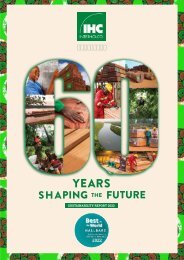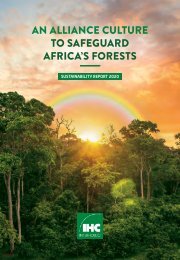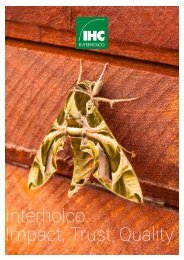Nomenclature Générale des Bois Tropicaux - 7ème édition
(english description below) Cette nomenclature est utilisée pour la mise à jour du 'Harmonized Code System' de l’Organisation Mondiale des Douanes. Dans la circulaire du 5 avril 2005, le Ministère de l’Economie, des Finances et de l’Industrie (France) reconnaît l’ATIBT comme « gardien du temple » de la nomenclature des bois tropicaux. La Commission Européenne mentionne la nomenclature de l’ATIBT comme document de référence pour la mise en œuvre du RBUE. Depuis 1954, l’ATIBT a établi et mis à jour une nomenclature des bois tropicaux faisant correspondre chaque espèce botanique avec un nom pilote reconnu internationalement. La détermination du nom pilote d’une essence est cruciale, car sa commercialisation dépend très largement de l’adoption de ce nom par le public. Le nom pilote assure la protection de l’appellation commerciale de l’essence et l’intégrité des propriétés qui lui sont attribuées, sans risque de confusion. The 1982 version of the general timber nomenclature has finally been updated as some of the 1,750 identified species, are no longer traded, while others, which were not previously included, are now on the market. The present revision has also integrated changes related to new taxonomy, in order to reflect the latest scientific developments. This Nomenclature has been used for the Harmonized Code System, updated by the World Customs Organization. The French Ministry of economy, finance and industry has given official recognition to ATIBT as the reference for the tropical timber nomenclature (NOR: PRMX0508285C of April 5th 2005). The European Commission refers to ATIBT nomenclature as a reference document for the implementation of the EUTR regulation. Since 1954, ATIBT has established and updated a nomenclature of tropical wood, linking each botanical species with an internationally recognized pilot name. A sigle wood species may have many common names; when trading across different countries, this may lead to confusion. Fixing the pilot name of a timber species is crucial, to protect the commercial denomination of the species and guarantee the veracity of the properties linked to that species, without confusion.
(english description below)
Cette nomenclature est utilisée pour la mise à jour du 'Harmonized Code System' de l’Organisation Mondiale des Douanes. Dans la circulaire du 5 avril 2005, le Ministère de l’Economie, des Finances et de l’Industrie (France) reconnaît l’ATIBT comme « gardien du temple » de la nomenclature des bois tropicaux. La Commission Européenne mentionne la nomenclature de l’ATIBT comme document de référence pour la mise en œuvre du RBUE.
Depuis 1954, l’ATIBT a établi et mis à jour une nomenclature des bois tropicaux faisant correspondre chaque espèce botanique avec un nom pilote reconnu internationalement. La détermination du nom pilote d’une essence est cruciale, car sa commercialisation dépend très largement de l’adoption de ce nom par le public. Le nom pilote assure la protection de l’appellation commerciale de l’essence et l’intégrité des propriétés qui lui sont attribuées, sans risque de confusion.
The 1982 version of the general timber nomenclature has finally been updated as some of the 1,750 identified species, are no longer traded, while others, which were not previously included, are now on the market. The present revision has also integrated changes related to new taxonomy, in order to reflect the latest scientific developments.
This Nomenclature has been used for the Harmonized Code System, updated by the World Customs Organization. The French Ministry of economy, finance and industry has given official recognition to ATIBT as the reference for the tropical timber nomenclature (NOR: PRMX0508285C of April 5th 2005). The European Commission refers to ATIBT nomenclature as a reference document for the implementation of the EUTR regulation.
Since 1954, ATIBT has established and updated a nomenclature of tropical wood, linking each botanical species with an internationally recognized pilot name. A sigle wood species may have many common names; when trading across different countries, this may lead to confusion. Fixing the pilot name of a timber species is crucial, to protect the commercial denomination of the species and guarantee the veracity of the properties linked to that species, without confusion.
Create successful ePaper yourself
Turn your PDF publications into a flip-book with our unique Google optimized e-Paper software.
Liste des noms pilotes des bois tropicaux avec renvoi aux noms scientifiques /// 51
Ako
PILOT NAME BOTANICAL NAMES COMMON NAMES
Akossika
Alan
Alep
Almàcigo
Almendrillo
Antiaris toxicaria Lesch.
(Syn. Antiaris africana)
(Syn. Antiaris welwitschii)
Scottellia klaineana Pierre
(Syn. Scottellia coriacea)
Shorea albida Symington
Desbordesia insignis Pierre
(Syn. Desbordesia glaucescens)
(Syn. Desbordesia pierreana)
Bursera simaruba Sarg.
Taralea oppositifolia Aubl.
(Syn. Coumarouna oppositifolia)
Akede (CI) ; Ako (CI) ; Andoum (GA) ; Bonkongo
(CD) ; Bonkonko (CD) ; Chenchen (GH) ; Diolosso
(CM) ; Guxotin (BJ) ; Kirundu (UG) ; Kyenkyen
(GH) ; Mkuzu (TZ) ; Mlulu (TZ) ; Mumaka (UG) ;
N’Dombou (CF) ; Nioumbou (CG) ; Ogiovu (NG) ;
Oro (NG) ; Sansama (AO)
Akossika (CI) ; Bilogh-Bi-Nkele (GA) ; Kelembicho
(CF) ; Koroko (GH) ; Korokon (LR) ; Kruku (GH) ;
Ngobisolo (CM) ; Odoko (NG)
Alan-Batu (BN) ; Alan-Batu (MY) ; Alan-Bunga (BN,
MY) ; Alan-Meraka (MY) ; Alan-Paya (MY) ; Meraka
(MY) ; Red Selangan (MY) ; Selangan Merah (MY)
Alep (GA) ; Benga (CD, CG) ; Kowo (NG) ; Omang
(CM)
Almàcigo (VE) ; Bois d’encens (GF) ; Chakah (MX) ;
Chiboue (GF) ; Chique (GF) ; Gommier blanc (GF)
Almendrillo (BO) ; Cumaru rana (BR) ; Shihuahuaco
(PE) ; Tarala (GF)
Almon Shorea almon Foxw. Almon (PH) ; White Lauan (PH)
Alumbi
Julbernardia seretii Troupin
(Syn. Berlinia seretii)
Amapola Pseudobombax ellipticum Dugand Amapola (MX)
Amberoi
Pterocymbium beccarii K. Schum.
Pterocymbium tinctorium Merr.
Pterocymbium spp.
Alumbi (CD) ; Mubangu (CD)
Amberoi (PG) ; Keluak (MY) ; Kelumbuk (ID) ;
Melembu (MY) ; Oi-Chang (TH) ; Papita (ID) ; Po-
Ikeng (TH) ; Po-Kradang (TH) ; Sawbya (MM) ;
Taluto (PH) ; Teluto (MY)
Amendoim Pterogyne nitens Tul. Amendoim (BR) ; Ibiraro (PY)
Amesclào
Amourette
Amvout
Andira
Andiroba
Tetragastris altissima Swart
Tetragastris panamensis Kuntze
Tetragastris spp.
Trattinnickia spp.
Brosimum guianense Huber
(Syn. Piratinera guianensis)
Trichoscypha acuminata Engl.
Trichoscypha oddonii De Wild.
Andira coriacea Pulle
(Syn. Andira wachenheimi)
Andira inermis DC.
(Syn. Andira jamaicensis)
Andira parviflora Ducke
Andira spp.
Carapa guianensis Aubl.
(Syn. Carapa nicaraguensis)
Carapa procera DC.
Amesclào (BR) ; Bois cochon (GF) ; Breu grande
(BR) ; Breu manga (BR) ; Breu preto (BR) ; Breu-sucuruba
(BR) ; Copal (EC) ; Encens rouge (GF) ; Grand
Moni (GF) ; Haiawaballi (GY) ; Joeliballi-Tataroe
(GY, SR) ; Masa (PR) ; Morcegueira (BR) ; Palo Cochino
(CU) ; Palo de aceite (PR) ; Sali (GF) ; Salie
(SR) ; Tingimoni (SR) ; Trementino azucarero (CO) ;
Ulu (GY)
Amourette (GF) ; Belokoro (SR) ; Letterhout (SR) ;
Lettre moucheté (GF) ; Palo de Oro (SR) ; Peni-Paia
(SR) ; Poevinga (SR)
Amvout (GA) ; Ekon mvut (CM)
Acapurana (BR) ; Almendro de Rio (BR) ; Andira
(BR) ; Andira Uchi (BR) ; Angelim (BR) ; Angelin
(TT) ; Bat Seed (GY) ; Congo (CO) ; Koraro (GY) ;
Maquilla (MX) ; Mocha colorado (CR) ; Moton
(EC) ; Quinillo colorado (PE) ; Roode Kabbes (SR) ;
Saint Martin rouge (GF) ; Sarrapio Montanero (VE)
Andiroba (BR, PE, PY) ; Andiroba branca (BR) ;
Andiroba vermelha (BR) ; Andirobeira (BR) ; Bastard
Mahogany (HN) ; Carapa (BR, GF, VE) ; Cedro bateo
(CR, PA) ; Cedro macho (CR, HN, PA) ; Crabwood
(GY) ; Crappo (TT) ; Figueroa (EC) ; Güino (CO) ;
Krappa (SR) ; Masabalo (CO, VE) ; Mazabalo (CO) ;
Nandiroba (BR) ; Tangare (EC)














